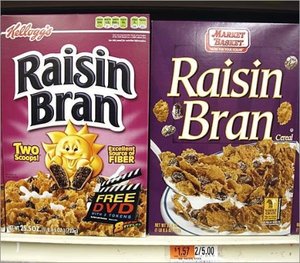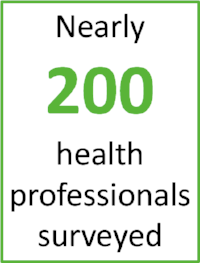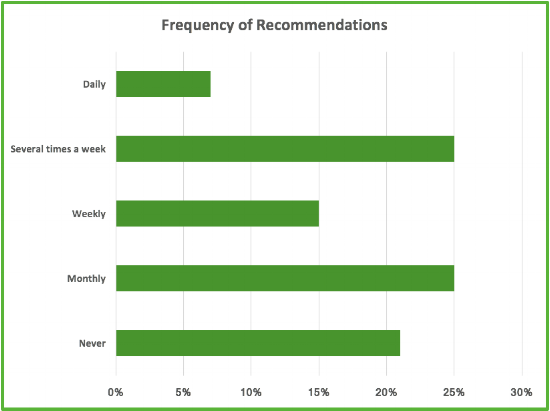
Keep on top of trends, new products
&
best practices for sharing your influence with the people you serve.
Marketers of Healthy Brand-Name Products: Take Advantage of Your Advantage!
The 2017 IFIC Survey showed that consumers already trust brand-name products over their nutritionally equivalent generic counterparts. This perceived health halo is a huge advantage that marketers of healthy brands don't always take advantage of. You can build on this trust three ways.
Picture this: A consumer is walking up and down the aisles of the grocery store doing her weekly shopping, and she stops to grab a product off the shelf. There are two choices. One is a brand-name product, and the other is the store's generic equivalent. Both products have the same ingredients and nutrition facts. Which one does she choose? According to the 2017 IFIC Food and Health Survey, she's more likely to choose the brand-name product.
Why does the brand-name product have a perceived halo of health? Maybe the consumer thinks the ingredients, though the same, are of a higher quality. Maybe she assumes it was made with greater levels of safety and oversight. Or maybe she's just loyal to that particular brand-name product.
No matter the reason, one thing is for sure. Brands should take advantage of this advantage!
Three ways to build trust with a brand-name halo
Brands have an advantage when it comes to health perception, yet consumers are still skeptical about what they say about their healthy eating. In fact, according to the IFIC survey, food brands are consumers’ least-trusted source of information on which foods to eat or avoid. Healthy brands have a clear opportunity to build trust and relationships with consumers. This can be done three ways:
- Communicate directly with consumers
- Earn professional recommendations
- Position your products as part of a healthy diet
Direct communication
Sure, brands have invested significant resources in social media and online presences that are helpful or humorous, but that’s not how you build trust and credibility. Rather, brands should be transparent, relevant, open, and honest.
Professional recommendations
While food brands are consumers’ least-trusted source of information when it comes to which foods to eat and avoid, health professionals are their most-trusted source of information. When professionals recommend a specific food brand, they are communicating to their patients and clients that they approve of and trust the brand they are recommending. It is, essentially, a tacit endorsement. If healthy brands want to build trust, there's no better way than through an already-trusted source.
Product positioning
Consumers already perceive name brand-name products to be healthier than their generic versions, but be careful how you position yourself. Emphasize your brand's role as part of a healthy diet—just one player in a larger game—instead of suggesting you're the silver bullet for health.
Brands, you have a huge advantage that you should be capitalizing on. Consumers already perceive your products as healthy. Now it’s time to use that advantage to gain their trust as well.
Nothing is Complicated About Healthy Eating
Healthy eating is simple, but with the results of new studies being released every week, you'd think it was complicated. Why is this? Why do publications continue to report on new "findings" that aren't actually new and don't add value to the healthy-eating conversation? An article in The Atlantic explains.
It's actually quite simple. But with new studies coming out every week about healthy eating, it’s easy for consumers to get distracted and confused by the latest and greatest information.
It's easy for publishers, too: No one wants to keep reporting the same healthy guidelines (because no one wants to read them). That's the point of a recent Atlantic article, which argues that the so-called "new" data isn’t all that new and often makes healthy eating appear more complicated than it is.
“Eating in ways that are good for our bodies isn’t conceptually complicated. It’s complicated by money and time and access—but eating based on scientific findings is not.”
New studies will continue to emerge, but the basic guidelines for healthy eating will remain the same: lots of fruits, beans, seeds, vegetables, and whole grains, and few refined carbohydrates and sugar.
Are Frozen Fruits and Vegetables Just as Healthy as Fresh?
When asked, 87% of health professionals indicated that they believe frozen fruits and vegetables to be nutritionally equivalent to fresh. Some even believe them to be more nutritious than fresh, as frozen fruits and vegetables are picked and frozen at peak ripeness. Surprised?
Health professionals sure seem to think so. We were curious about the conversations happening around frozen foods, so we reached out to nearly 200 health professionals in our PulseConnect network to learn more. When asked, 87% of health professionals indicated that they believe frozen fruits and vegetables to be nutritionally equivalent to fresh. Some even believe them to be more nutritious than fresh, as frozen fruits and vegetables are picked and frozen at peak ripeness.
Frozen fruits & vegetables recommended weekly
Health professionals are recommending frozen fruits and vegetables. In fact, 88% of health professionals surveyed indicated that they are recommending frozen fruits and vegetables at least on a weekly basis.
Among those recommending frozen fruits and vegetables, 34% are doing so when talking to their patients and clients about eating a heart healthy diet. Health professionals emphasize that frozen fruits and vegetables are convenient, cost-effective, and nutritionally equivalent to fresh fruits and vegetables.
Health professionals recommended frozen fruit & vegetable brands
All frozen fruit and vegetable brands are perceived by health professionals as being healthy options, but some receive more recommendations than others. Want to know what health professionals are saying about your brand? That’s where we can help.
What Consumers Really Want When it Comes to Healthy Eating
According to the 2017 IFIC Food and Health Survey, a mere 14% of Americans followed a specific diet or eating pattern in the past year. With the exception of fad diets that are highly restrictive or based on questionable science, following a set eating pattern (like eating less sugar and more vegetables) is beneficial. Two things are necessary for consumers to do so: approachable guidelines and educational information from a health professional.
Whether it’s eating gluten free, following the Mediterranean diet, or being an adherent of Whole30 or Paleo, there is a seemingly never-ending supply of eating patterns and diets to meet every need or desire. While there’s no shortage of eating patterns and diets, few consumers are actually attempting them. In fact, according to the 2017 IFIC Food and Health Survey, a mere 14% of Americans followed a specific diet or eating pattern in the past year.
Given how much attention these eating patterns and diets receive in the media—both traditional and social—this might come as a surprise. It shouldn’t. These eating patterns and diets get lots of attention, but they’re often perceived by consumers as being hard to follow, intimidating or simply unsustainable in the long-run.
With the exception of fad diets that are highly restrictive or based on questionable science, following a set eating pattern or diet is a good thing. Even something as simple as reducing the consumption of processed carbs or added sugar while increasing the consumption of fruits and vegetables could be considered an eating pattern—and a good one at that. So what’s standing in the way of consumers and a healthy eating pattern or diet to call their own?
Approachable and realistic guidelines
When eating habits are extremely restrictive, eating healthy can seem nearly impossible, but healthy eating isn’t complicated—and shouldn’t be made to seem like it is. Rather than completely cutting certain foods out of their diet, like some diets require, it’s more realistic for consumers to make small changes to their eating habits. In fact, most of them are already doing just that. According to the IFIC survey, 80% of consumers said they have already made small changes to achieve an overall healthier diet.
These small changes are easiest to implement if they come in the form of simple guidelines that are easy to follow and flexible. Guidelines such as drinking more water, reducing sodium intake, eating more fruits and vegetables, eating more foods with whole grains, and consuming smaller portions are both approachable and realistic. They’re so approachable, in fact, the IFIC survey found that over half of all consumers are already taking steps to incorporate these changes into their eating habits.
Small changes and simple guidelines that consumers can follow get them moving in the right direction, build momentum through early successes, and put them on a sustainable path toward their desired health goals.
Educational information from a trusted source
So where can consumers get these guidelines? The internet is filled with information about eating patterns and diets; however, far too much of that information is inaccurate and has the potential to leave consumers confused, misinformed, and overwhelmed. When adopting healthier eating habits, consumers need to make sure they’re getting their information from a trusted source, such as a health professional.
Not only are health professionals the most trusted source of consumer health information, they are also experts in their fields and are not easily swayed by trends or fads. Health professionals can provide much-needed context and present consumers with the basic guidelines they should follow in an understandable and actionable way.
Will consumers ever fully embrace all-encompassing diets and eating patterns? Probably not. But just because most consumers aren’t taking on a complete diet overhaul doesn’t mean they aren’t taking steps toward healthier eating, they just prefer small steps. When it comes to healthy diets and eating patterns, consumers need guidelines that are approachable and realistic that come from a trusted source.
Are Health Professionals Recommending Frozen Entrées as a Healthy Option?
The results from our latest survey about frozen foods show which brands health professionals are recommending most often when they suggest frozen entrees for healthy weight management to their clients face-to-face each week.
As we mentioned in last week's blog post, we wanted to know if health professionals are recommending frozen entrees, so we reached out to nearly 200 health professionals in our PulseConnect network. The survey results show that they are recommending frozen entrees on a regular basis. But, of course, they’re not recommending every brand. Here’s what we found.
Frozen entrées recommended weekly for weight management
Sixty-three percent of health professionals surveyed indicated that they are recommending frozen entrées on a weekly basis.
Among them, 50% are doing so when talking face-to-face with their patients and clients about losing weight or maintaining a healthy weight. Health professionals emphasize that frozen entrées are convenient, portion-controlled, and easy to prepare.
Frozen entrée brands favored by health professionals
The most frequently recommended frozen entrée brands include Lean Cuisine, Healthy Choice, Kashi, and MorningStar Farms. Though these brands are among the most well-known, they are not necessarily perceived to be the healthiest options.
Smaller brands like Luvo and Evol actually out-rank most of the better-known brands when it comes to perceived healthfulness. In fact, Luvo and Evol are viewed by health professionals who are aware of them as being among the top three healthiest frozen entrée options. They simply lack the awareness needed to be more frequently recommended.
We have data on 16 frozen entrée brands. Want to know how your brand stacks up? That's where we can help.
Retailers are Making the Investment in Health & Wellness
Consumers care about health and wellness, but do retailers? Actually, they do. According to this SmartBrief article, a recent FMI report found that food retailers are investing in health and wellness more than ever before.
Consumers care about health and wellness, but do retailers? Actually, they do. According to this SmartBrief article, a recent FMI report found that food retailers are investing in health and wellness more than ever before.
In-store dietitians, product sampling, healthy recipes, and good-for-you products are just a few of the steps food retailers are taking to further their investment in health and wellness. So why are they doing it? Where food retailers’ health and wellness efforts used to be merely transactionally-focused, they’re now more strategic. According to the report, 72% of retailers are investing in health and wellness to grow their own store brand and 61% are doing it to help them keep up with the health and wellness efforts of their competition. Other retailers indicated doing so in hopes of increasing their customer loyalty.
“Eighty-one percent of the food retailers in this survey (up from 70% in 2014) currently view supermarket health and wellness programs as a significant business growth opportunity for the entire industry in the years ahead.”
If food retailers are taking a more strategic view of health and wellness, it’s imperative that food brands think about it strategically as well. After all, brands are the real marketing experts.
How can brands do it? We’ll touch on that soon.
Are Health Professionals Recommending Frozen Food as a Healthy Option?
Are health professionals talking about frozen foods? If so, what are they saying? We were curious, so we reached out to nearly 200 health professionals in our PulseConnect network to see if they were recommending frozen foods and to learn more about the conversations happening around this category. You may be surprised to learn which heart-healthy frozen food is recommended every week.
The answer is yes. Frozen food brands are being recommended by health professionals every single week. To find out if your brand is among them and how frequently it's being recommended, keep reading.
For more than 18 years, Pulse Health & Wellness has been placing healthy food brands at the center of face-to-face interactions between trusted health professionals and the consumers they counsel. PulseConnect, our dynamic network of health and wellness professionals, is the mechanism that drives these interactions—and fuels research.
This summer, we reached out to nearly 200 network members to see if they were recommending frozen foods and to learn more about the conversations happening around this food category. This is one of our findings.
Frozen meat alternatives recommended weekly for a heart-healthy diet
Health professionals are talking about frozen foods. In fact, nearly 50% of health professionals surveyed indicated that they are recommending frozen meat alternatives on a weekly basis.
Among those recommending frozen meat alternatives, almost 1 in 3 are doing so to encourage eating a heart-healthy diet. With less saturated fat and less cholesterol than meat-containing products, meat alternatives' heart benefits are an easily understood benefit.
Health professionals' favored frozen meat alternative brands
Health professionals are recommending the frozen meat alternatives of primarily two brands: MorningStar Farms and Boca. While these brands have the highest awareness and most recommendations, their perceived healthfulness is being challenged by smaller, newer brands.
Gardein, Lightlife, and Beyond Meat are perceived as being just as healthy, but they lack the awareness needed to garner the coveted health professional recommendations.
How we can help your brand stand out in this category
So how do the well-known brands do it? That’s where we can help. Based on our findings, we created a ranking system that takes into account brand awareness, recommendations, and perceived healthfulness.
Because at the end of the day, if health professionals aren’t recommending your brand, who's brand are they recommending?
If you’d like to learn more about our ranking system and how we can help you become a part of the conversation, contact Kevin McDonnell at kevinm@pulsehw.com.
The Gluten-Free Trend is Right on Trend (and on Its Way Out)
Though a gluten-free diet was initially thought to reduce the risk of heart disease and help with digestive issues, registered dietitians say that if it is not medically necessary, eliminating gluten may be doing consumers more harm than good. And that's why this trend is, like all others before it, on its way out.
Has another food trend come and gone? It seems that way. According to registered dietitians in a recent U.S. News article, the gluten-free trend is on its way out.
As with other food trends, many consumers made the jump to gluten-free eating prior to having all the information. Though it was initially thought to reduce the risk of heart disease and help with digestive issues, registered dietitians say that if it is not medically necessary, eliminating gluten may be doing consumers more harm than good. After all, grains are an important source of nutrients and it is recommended that consumers eat around 6 ounces every day as part of a healthy diet.
“As with all fad diets, we’re starting to see this one wane.”
The declining gluten-free trend is right on trend. Many other past food trends, such as Paleo, low-fat, and low-carb diets have followed the same path, they simply don’t last. The trends begin as immensely popular but quickly fade away, only to be forgotten by consumers. So why aren’t these food trends lasting? Probably because consumers don’t want to make the drastic changes required to follow these specific diets. In fact, the 2017 IFIC Food and & Health Survey found that only 14% of consumers followed a specific eating pattern or diet in the past year. Sure, consumers want to eat healthy, but completely changing the way they eat is simply not sustainable in the long run.
What will the next food trend be? Who knows. What we do know is that rather than large changes, consumers want products that fit easily into their lives and, at the same time, are good for them and have proven health benefits.
PulseConnect Member Interview: Cheryl Cohen
The face-to-face conversation that health professionals have with their clients is the single most important marketing opportunity for a healthy brand to be a part of. The implicit trust of the client-consumer for the professional-influencer is unmatched, as is the influencer's genuine desire to help the consumer. We spoke with an influencer and PulseConnect member Cheryl Cohen about her work and the types of conversations she has with her patients
The face-to-face conversation that health professionals have with their clients is the single most important marketing opportunity for a healthy brand to be a part of. The implicit trust of the client-consumer for the professional-influencer is unmatched, as is the influencer's genuine desire to help the consumer. We spoke with an influencer and PulseConnect member Cheryl Cohen about her work and the types of conversations she has with her patients.
Tell us a little bit about what you do and the types of people you work with.
I’m a nurse practitioner with a background in food and nutrition. For the last five years, I’ve helped adults in New York City hospitals with diabetes or cardiac conditions transition back to the home. After seeing them in the clinic or hospital, I follow up with phone calls and sometimes visit them in their homes. If necessary, I also help them navigate the super markets. It’s so exciting, after they’ve expressed such frustration, to hear about their accomplishments and see them sustain their joy.
Do you think your clients are more vulnerable with you about their diet/exercise struggles than even their best friends or spouses?
Each patient is different. It depends on how much education I give them before they go into the home. If the family members are part of the learning experience and can assist the patient with their diet, shopping, etc., then patients learn a lot more.
Do they come to you confused by conflicting news coverage about nutrition and exercise?
They come with questions. I encourage them to write down their questions, including the sources of their information, and to keep evidence-based journals. I like to believe that if you educate the patient, he is more informed. He’ll ask better questions. No question is too small or too silly because it's something we can explore together.
I also give them a handout when we first meet, which we go through together — me with the patient or me with the patient and his family. After he understands it, we go over the questions from everyone, and then he signs the handout. I get a cop, and he gets a copy. That way I can reference it when he has questions later to remind him that he already knows the information. Patient education is so important — even navigating the Internet. So, for example, we Google “gluten” and see what comes up, we talk through the results and where they’re coming from.
How do you earn the trust of your clients as a health professional? Do they take the advice you give at face value, or do they question you and your methods?
Each patient is different, and I have to earn their trust by speaking to their level of understanding. I always like them to repeat what I tell them, so I know they understand. Anxiety is such a big aspect of their learning. It takes one or two visits to earn their trust. Once we get past the anxiety, they're more accepting of the information I give them.
At Pulse, we value the face-to-face, one-on-one conversations you’re able to have with your clients and our brands’ potential consumers. How often do you get to have those high-value interactions with your clients?
Very often. When we meet in the office, they tend to bring the questions they wrote down. Then they read them to me in a hurry because they know there’s a time restraint, so they rush. That’s why it’s so important to reach them on the phone afterward to follow up…and maybe even go to their home. So, the bulk of my work is one-on-one.
What tests must a product pass before you feel confident in recommending it to your clients?
Mostly, I look at the ingredients and taste the product. Some of the products I get samples of, or I speak with colleagues who have tasted the products.
Consumers Build Healthy Habits, not Trendy Habits
The internet has given consumers unprecedented access to free information about nutrition, food, how it’s made, and the companies making it. As a result, consumers have become more aware — and wary — of what they’re eating. Trends and perceptions come and go, but when all is said and done, consumers of healthy brands want just three things.
The internet has given consumers unprecedented access to free information about nutrition, food, how it’s made, and the companies making it. As a result, consumers have become more aware—and wary—of what they’re eating.
With this new-found knowledge, consumers are demanding that the products they buy live up to ever-changing standards of high quality. Much of this can be attributed to perception, something the organic market, for example, has benefited from for years. Thanks to consumers’ perceptions that organic foods are healthier than non-organic, the organic market is experiencing huge growth from the meat and dairy cases to the produce section. Similarly, consumers are less inclined to purchase food that has been genetically modified, convinced this makes food less healthy. Marketing history is filled with even more examples of trend-driven foods—think fat-free and low-carb.
Trends and perceptions come and go, but when all is said and done there are three things consumers want:
- A product that’s good for them
- Proof of its health benefits
- The ability to easily fit it into their lives
A healthier or better-for-you product
Consumers have enough distractions as it is with all the noise on the internet and in magazines surrounding what’s healthy and what’s not. So, when it comes to what a product has to offer, why make it complicated? Our advice? Keep it simple. Focus on the important things, like how it can help your consumer can reach their health and wellness goals. It doesn’t have to be flashy but it does need to be easy to understand and actionable.
By providing easy-to-digest, fact-based information, brands can show consumers that they are focused on providing them with a healthier alternative. Though trends and consumer perceptions may change, consumers will always want the facts.
A recommendation from someone they trust
Though consumers get their information from a variety of sources, health professionals remain the consumer’s most trusted source nutrition information. According to the 2017 IFIC study, two-thirds of consumers have high trust in their conversation with a health professional as opposed to the approximately only one-quarter who have high trust in a health, food, or nutrition bloggers. Reaching consumers through health professionals is effective because it’s someone the consumer already trusts and has a relationship with.
Health professionals don’t fall prey to trends. We recently conducted a survey of health professionals who ranked “natural,” “certified organic,” and “non-GMO” as the least important of 27 attributes. Among those ranked as most important by the professionals, were health benefits like protein, calcium, and fiber content. Clearly, health professionals base their recommendations on facts, not trends.
A product that easily fits into their life
The 2017 IFIC Study also touches on the steps consumers take to be healthier. Nearly 80% of consumers indicated they have made small changes to achieve an overall healthier diet. However, a mere 14% of consumers indicated they followed a specific eating pattern or diet in the past year. Why is this? Consumers want to be healthier, but when it comes to change they like to take small, simple steps toward better health.
Consumers want to build healthy habits, but don’t want to have to completely change their routine, their shopping habits, or the things they cook to do so. Therefore, brands should show consumers their product is a stepping stone toward better health, and how they can incorporate a new product into their lives without disruption. Consumers are much more likely to take action if they don’t have to invest in wholesale changes.
Will consumer perceptions of health and nutrition change in the coming months and years? Probably. Since some change is inevitable, it is in a brand’s best interest to focus on the things that don’t change. Give the consumers a healthy product, a valued recommendation, and a product that easily fits into their life.


















